4/12-4/16
This week was pretty much a study week. We worked hard and learned a lot but also had a few adventures.
On Wednesday we made granola. I’ve never made granola before and thought that it would be rather complex and messy. It turns out it’s very simple. We decided to use most of the leftover dried fruit and nuts from my stash as well as all the stuff Jason brought over for the non-oatmeal ingredients. Amazingly during the entire process we only managed to spill a little, and no one burned or cut themselves or anything else! It was very fun.
Thursday was good. The person who was supposed to come couldn’t, which was disappointing, but we got to spend the day working on our proposals and finding the papers we needed for our projects. It was a somewhat relaxing day, though study intensive, and we all needed it.
On Friday afternoon, about two o’clock, we jumped off of the Friday Harbor Lab’s dock. It was excruciatingly cold. It is tradition for the Beam Reach students and faculty to jump off of the dock before the first sail, so there we were looking with great trepidation into the freezing water hoping desperately that something would intervene. We had told the rest of the FHL population that we would be doing this during the first week and amazingly enough a few students from the other programs joined us in our cold plunge. Of course Jason and Val jumped first since they weren’t as scared of the water as the rest of us. But we soon followed. 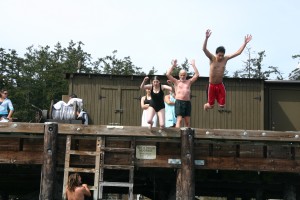 On my first jump, after getting over the sudden “oh my god so cold!!†feeling, I swam over and climbed up the ladder that leads up to the tall dock. On my second jump Horace and I, with a 3..2..1.. countdown/encouragement from Val, jumped from the tall dock. I have to say, the stomach dropping feeling of jumping from high places does nothing to distract from the cold shock. On his first dive off of the tall dock, Val did an amazing swan dive. It turns out he used to dive competitively. Cool hunh!
On my first jump, after getting over the sudden “oh my god so cold!!†feeling, I swam over and climbed up the ladder that leads up to the tall dock. On my second jump Horace and I, with a 3..2..1.. countdown/encouragement from Val, jumped from the tall dock. I have to say, the stomach dropping feeling of jumping from high places does nothing to distract from the cold shock. On his first dive off of the tall dock, Val did an amazing swan dive. It turns out he used to dive competitively. Cool hunh!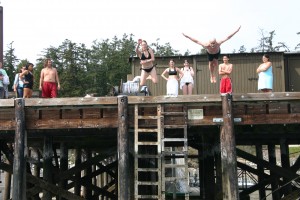
Although the water was cold it was exhilarating especially once you got out. Because plunging yourself into cold water causes reduced circulation on your skin, you feel downright warm after getting out! It was kind of weird seeing all of us walking around I our swimsuits dripping wet in 60 degree weather not cold at all.
All in all it was an interesting week.
Read More
Hello cyber sailors,
All packed and ready to leave tomorrow for 2 weeks. I am pretty sure my internet will be lacking from the sailboat, but hopefully I will return with tales to fill your webspace.
This past week went really quickly, beginning with a visit from a few good friends! It was great to see and explore San Juan Island with them, go for a hike up Mount Young, visit English camp, and eat some fried food in town. I took a ton of flower/plant pictures.
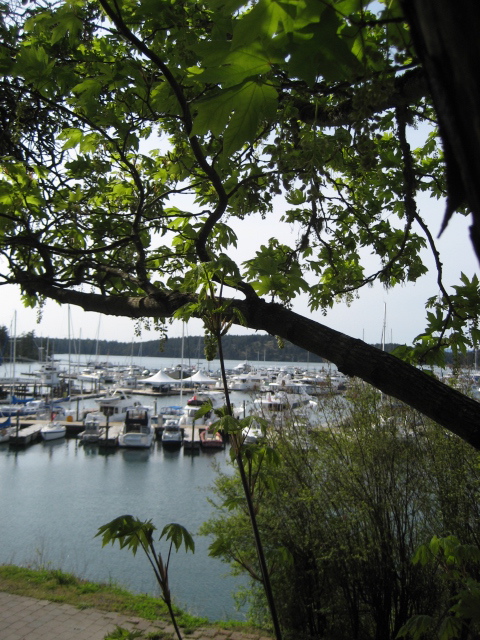
Roche Harbor
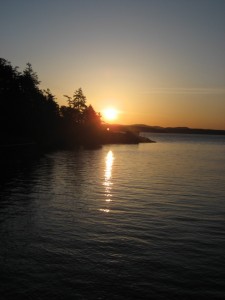
Sunrise. Waiting for the ferry
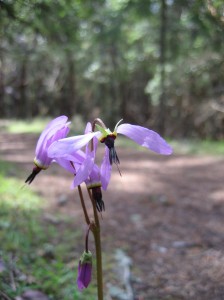
Flower on the hike up Mount Young
Remember when I said I would love to help do a necropsy on the sea lion from last week? Well, it happened. I got to be knee deep in the intestines of a marine mammal and let my inner child and scientist run free! I am not attaching any photos because they are bloody, but if you would like to see some, let me know.
Schoolwork and proposals filled the rest of the week, but my stories come from a late night walk.
I like to sit at the dock after the sun goes down and look at the stars, see the lights reflecting off the water from Friday Harbor, and listen to the quiet. I have started remembering to bring my headlamp lately for fear of sneaking up on some raccoons and deer that hang out in the area. They must hear me coming, but each time I come around a corner, they scare me worse than I scare them. So, I have become cautious with peaking around corners and checking each building parameter for creatures.
Last night I went for such a walk and was admiring the water critters that glow with a reflective light. I was playing around with seeing if they still glow with a red light – and they do! How cool is that? Just then, I thought that my imagination was running wild because it was like I was in a sci-fi film. Two large, beady red eyes with a small red line between them were flying toward me from about ten feet off the dock in the water. It was moving to quickly. By the I fumbled my headlamp into the white light position, it was almost at my feet. To my surprise, it was not my imagination at all but a sea otter who ducked under the dock just as I to the white light stable enough to spot him. From that point on, I decided to step back a bit, just in case he decided to jump onto the dock. I didn’t want to surprise him by being the landing pad.
I was slowly lulled back into my comfort zone by the stars above and talking to Loretta on the phone. Each little squeak and creak registered in my ears, but my logic told me to calm down, the adventures were probably over for the night. After all, the otter knew I was there, so it would logically leave me alone.
I sat for a long time in the dark, but the dock is pretty uncomfortable, so I laid down to get a better view of the stars. The squeaks of the fender against the boat, the dock shifting, and something else kept registering in my brain. Then, I couldn’t identify the noise. There were a number of squeaks that seemed too close to be the boat (mind you, my head is on the ground), so I turned my face to the right to help identify the noise.
Not three feet from my cheekbone was a large rodent! I screamed bloody murder and jumped to my feet just in time to see a rat butt scamper across the adjoining dock and disappear into the darkness. I picked up my wits and pretty much jogged the 50 or so feet to safe ground. There is something about the body’s reaction to fright that is impressive. You really can move quickly, be completely aware of your surroundings, and see better, even in the dark. Don’t get me wrong, I am pissed that I keep getting lulled into this sense of security, then proven a fool. It’s like the animals here are as upset that I’m in their space as I am with them in mine. I actually enjoy periodically running into beautiful wild creatures…but on the dock….at night….3 feet from my face…? That’s a little much for me.
I went to the safety of the indoors to finish my conversation and had almost forgotten about the whole thing by the time I started walking home. By almost I mean that my heart might never forget and my light was on top alert. I checked all the normal raccoon spots with no sightings and was getting relieved as I got close to home. I was distracted by something in one of the buildings just enough that I momentarily forgot about my frightening encounters until I glanced over to the right to see three raccoons, frozen and five feet from me, waiting for me to pass…hoping they would go unnoticed. Geez. Talk about topping off an evening. It’s hard to rest easy when your body has been startled into alert three times in one evening stroll.
I don’t know if I am brave enough to venture to the dock alone again tonight. It is so pretty…I just can’t help myself.
Yesterday was the “cold plunge†where everyone in our program invites the community to join us in jumping over the dock into the Salish Sea water. I grew up in cold water and used to love swimming in the pool while it was filling up with water from the hose (brrr), but this is slightly different. The air was warm enough for Washington, but when you look around at dinner, there are a few winter jackets in sight. We stripped to our bathing suits and jumped into the breath-taking water. Even I came up for a breath with a start. Not to be outdone by our instructor, I jumped in a few more times from the top of the dock, which is about 20 feet from the surface of the water. Surprisingly, my body felt quite warm in the air compared to the water temp. It was not as bad as I might have thought, and we decided that in order to live a little, we might do it again just for fun. (http://www.beamreach.org/gallery/v/101/coldPlunge/)
The sailboat leaves tomorrow so I am packing my life into one bag once again, this time in search of orca whales.
I hope that all is well!
~libby
Read More
Just a note, farther down this blog entry are graphic pictures of insides of a marine animal. If this kind of thing disturbs you please don’t read past 4/8.
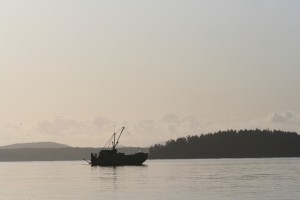
4/5
This morning a very cool guy named Russell came to talk to us about the juvenile salmon that use the San Juan Islands as a nursery. It was a very interesting talk and I learned quite a bit about the ecosystem that salmon spend their juvenile time in and how we can affect it.
After he left Jason taught us about the anatomy of whale sound production and reception. It was extremely cool! The anatomy of sound production and reception between terrestrial and aquatic mammals is very different and even the production difference between baleen and toothed whales is pretty significant. Whales don’t hear through holes on the surface of their heads like we do, instead they most likely hear through the surface of their head and along their jaw! I find the different ways that animals evolve amazing, especially things like basic senses.
After lunch we went down to the dock to play with the recording equipment. We got to lower a microphone to make sounds, one of the orca calls on a loot, that we could then record with the hydrophone. It was great. We each did all of the different jobs from moving the hydrophone box and recording, to measuring the distance between the hydrophone and the speaker. About half way through we saw a harbor seal pop up to look around. We surmised that it was looking for the predators it could hear under water. It was pretty cool.
When we got back to S1, the duplex we live in, we entered the data into Excel and made a graph. Most of us are still a bit confused but we will be doing more tomorrow since our lecture got cut short. We did learn that “The log of a number (x) = the power of a base that gives you the number (x)â€.
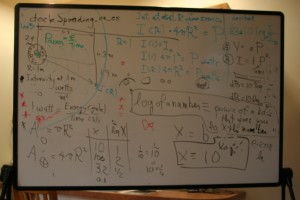
Val’s Board
4/6
We spent the morning learning a bit more about sound and how it is related to energy. That was pretty cool and a little less confusing. It is amazing seeing Val work on the board because you can tell that he loves what he does and he gets so into it!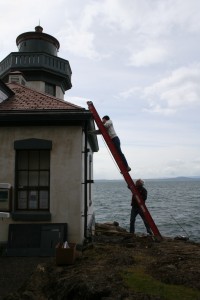
After that lecture we go to head down to Lime Kiln to clean out the lighthouse as part of our group community work. It was actually quite fun and very therapeutic. Horace and Val replaced the radio tower that streams live sounds to people with receivers in the park. 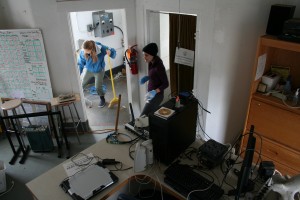 Kathryn, Libby, Jason and I worked at cleaning out the lighthouse and organizing the computers. After the inside was mostly put together I got to take the grounding wire from one side of the rocks below the lighthouse and move it to the other. Basically I got to jump around on rocks with a green wire for 30 min! It was fun!
Kathryn, Libby, Jason and I worked at cleaning out the lighthouse and organizing the computers. After the inside was mostly put together I got to take the grounding wire from one side of the rocks below the lighthouse and move it to the other. Basically I got to jump around on rocks with a green wire for 30 min! It was fun!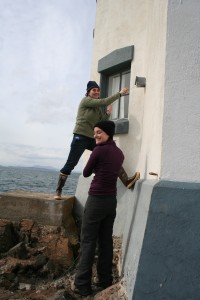
4/7
The proposal rough draft is due tomorrow so today is study study work work!
4/8
We had a very informative lesson on statistics today from Jason. We were introduced to the “Happy Face Stats Family†which entertained us all while being very informative.
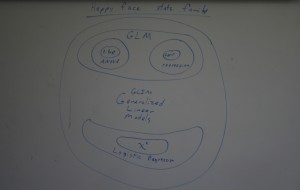
Happy Face Stats Family
Around 12:30 ish Jason got a call from Amy, a person who then informed us about a stranded sea lion 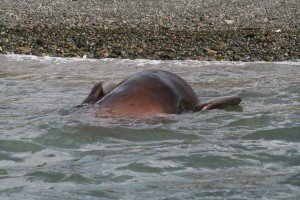 that she needed us to pick up. We set out about 40-50 min later in the buzzard to pick up a sea lion that was floating in a harbor. When we got there the sea lion had washed to the shallows on the beach and, although the Buzzard is made for that kind of situation, Jason didn’t want to get too close to shore cause getting back out to sea can still be problematic. So we went to the beach to inspect our options and decided to have two people, Horace and Libby, stay with the sea lion, tie a rope around its flippers and throw us the line so we could drag it back out to sea. The sea lion was still in pretty good condition and w
that she needed us to pick up. We set out about 40-50 min later in the buzzard to pick up a sea lion that was floating in a harbor. When we got there the sea lion had washed to the shallows on the beach and, although the Buzzard is made for that kind of situation, Jason didn’t want to get too close to shore cause getting back out to sea can still be problematic. So we went to the beach to inspect our options and decided to have two people, Horace and Libby, stay with the sea lion, tie a rope around its flippers and throw us the line so we could drag it back out to sea. The sea lion was still in pretty good condition and w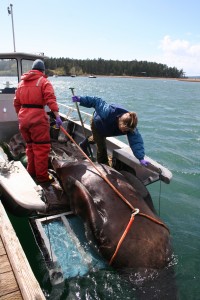 as just a bit bloated so it floated really well. Of course by this time it had started to hail and snow! After we got back to the dock we decided that the best cores would be to pull sea lion into the boat. This was a big mistake! We tied the rope around its feet to the winch and started to winch it into the boat, when we had about half of the sea lion in the boat the winch broke! For the next 20 min or so we tried to pull it in by hand. Not an easy feat as you may imagine since it weighed about 1 ton. Finally the winch came back, as did the sun, and we got the sea lion in the boat. Te sea lion firmly on the boat and all of us perched on the back to balance out its shear mass, we set out only to realize that the wind had picked up and the boat was too heavy. So we went back to the dock, pulled the sea lion off the boat, by tying it by its armpits to the dock and the other to the boat and driving away, and cinch it to the dock so we could come back the next day and pick it up. Then we rode home and got back about 4:45. I slept well that night!
as just a bit bloated so it floated really well. Of course by this time it had started to hail and snow! After we got back to the dock we decided that the best cores would be to pull sea lion into the boat. This was a big mistake! We tied the rope around its feet to the winch and started to winch it into the boat, when we had about half of the sea lion in the boat the winch broke! For the next 20 min or so we tried to pull it in by hand. Not an easy feat as you may imagine since it weighed about 1 ton. Finally the winch came back, as did the sun, and we got the sea lion in the boat. Te sea lion firmly on the boat and all of us perched on the back to balance out its shear mass, we set out only to realize that the wind had picked up and the boat was too heavy. So we went back to the dock, pulled the sea lion off the boat, by tying it by its armpits to the dock and the other to the boat and driving away, and cinch it to the dock so we could come back the next day and pick it up. Then we rode home and got back about 4:45. I slept well that night!
4/9
Today we got a call from Jason at 7:15 telling us that he was heading back out to pick up the sea lion at 7:45 and of course all of us once again jumped on the chance. 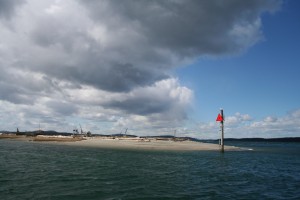 The ride out was very smooth and absolutely gorgeous! Â We got there quickly and found him in the same spot we left him, tied to the dock. We unhooked him and decided that since we had ropes around his tail, torso and snout we should tie him to the side of the boat rather than hope that we could get him all the way back to the labs towing him. Because of our extra load and the careful manner in which we drove, it took us about an hour to get back to the labs.
The ride out was very smooth and absolutely gorgeous! Â We got there quickly and found him in the same spot we left him, tied to the dock. We unhooked him and decided that since we had ropes around his tail, torso and snout we should tie him to the side of the boat rather than hope that we could get him all the way back to the labs towing him. Because of our extra load and the careful manner in which we drove, it took us about an hour to get back to the labs.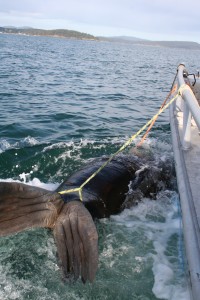
We were met there by whale museum volunteers who often assisted the Orcus Island veterinarian named Joe who routinely performs necropsies on stranded animals that are brought to the labs that are still in good shape. Joe hadn’t gotten there yet but Jason called him and it was decided that it would be best to perform the necropsy in the boat. So once again it was ‘haul the 1 ton sea lion into the boat’ time! The winch broke AGAIN but only for a few minuets and since we had some experience it went much quicker this time. After the sea lion was in the boat and we took some measurements of girth, length, etc., Joe got down to business. It was awesome!
I have ever seen a necropsy, excluding cat lab in college and the few frogs and squid from elementary school. The shear size of everything boggled my mind. The heart was the size of my head! Its blood has two kinds of oxygen carriers in it making the muscles look very dark red and it had a good 3 inches of blubber. During the necropsy Joe would quiz us on different parts and explain what he was doing. He was great and answered all of our questions.
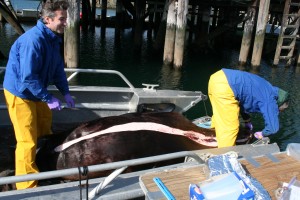 We found out that the sea lion has suffered some major trauma and had a lot of hemorrhagic tissue in his chest cavity. Trauma like that was most likely caused by a run in with a ship or some orca. We got to look at a bunch of different organs up close and Joe even went through the anatomy of the heart and cut it open for us to look at all of the parts. The liver was strange because it had abnormal yellow and black spots on it but Joe didn’t know if it was just a natural oddity or a sign of disease. The kidneys were also interesting because instead of having one outer area filtering into one inner area like ours, it basically had hundreds of little kidneys all filtering into one area.
We found out that the sea lion has suffered some major trauma and had a lot of hemorrhagic tissue in his chest cavity. Trauma like that was most likely caused by a run in with a ship or some orca. We got to look at a bunch of different organs up close and Joe even went through the anatomy of the heart and cut it open for us to look at all of the parts. The liver was strange because it had abnormal yellow and black spots on it but Joe didn’t know if it was just a natural oddity or a sign of disease. The kidneys were also interesting because instead of having one outer area filtering into one inner area like ours, it basically had hundreds of little kidneys all filtering into one area.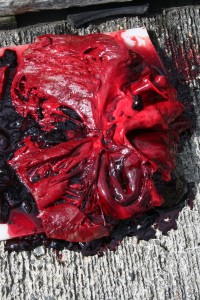
After Joe was finished with the necropsy it was about 12:30 and time for us to eat lunch lest we miss it! After lunch we got finished cleaning the boat, a very stinky and messy job, and then got sailing lessons from Val in his sail dingy.
The first time we went out we were with Val so he could explain what to do. Libby and Kathryn were first and then Horace and I went. The second time all four of us went, that was hilarious because we barley all fit into the boat! After that Val put on the jib sail and we went out in our pairs of two, this time without the guidance of Val. Libby and Kathryn did good as did Horace and I, given that none of us really knew what we were doing. Horace and I got stuck in no wind areas a few times and spent a lot of time going in circles. It was a lot of fun and a great end to a stressful week!

In case you missed it no lunch was actually mentioned.
Be joyous!
Read More
Hello everyone!
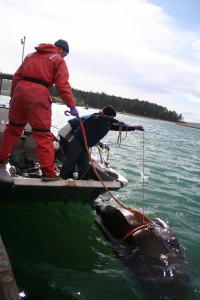
Walking the sea lion around the bow
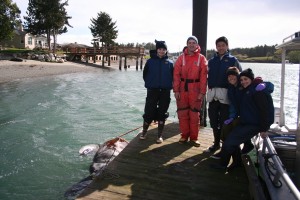
The team!
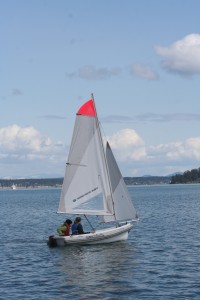
Me and Libby sailing
Sorry for the silence – between turning in a rough draft of our project proposals, participating in a Steller sea lion necropsy, and venturing out into the bay on our first sailing trip, we have been a bit short on free time. Even though this past week was somewhat of a whirlwind, I am truly in awe of how much information I absorbed. We had seminars on advanced acoustics, scoured the scientific literature for papers relating to our proposal topics, and got our first taste of boat life during excursions on the R/V Buzzard and Val’s dinghy. I learned how to hoist a 1-ton, male Steller sea lion out of the ocean amidst hail and wind, and I learned about its fascinating anatomy and physiology as I watched a marine mammal scientist conduct a necropsy. This was probably the most exciting part of our week (as evidenced by my fellow bloggers’ posts), and it was certainly a unique experience.
When Jason approached us about picking up a dead sea lion on Lopez Island, I was dragging my feet, just trying to make it through the day after staying up late finishing my proposal. Almost instantaneously, my head felt lighter and my face lit up – the mere prospect of setting foot on any kind of boat was enough to lift my spirit. Since other blog posts have already chronicled the beginning of our sea lion adventure, I will keep this part of my blog post short. Suffice it to say that attempting to pull an animal the size of a couch into our little boat (during a hailstorm) was very interesting…as was trying to pull him out again after discovering he was too heavy to keep in the boat. Several kind locals allowed us to tether the sea lion to their dock for the night with the understanding that we would be back early the next morning to retrieve him.
Picking up the sea lion the next day was a much less trying experience than our initial retrieval operation; this time we had the weather on our side. We tethered him to the side of the boat and started back (slowly) toward Friday Harbor Labs. As we rode back, I started to become uneasy about conducting a necropsy – wasn’t it disrespectful to mutilate this creature, even in “the name of science?†I had never spent so much time with an animal I was about to cut open, and I struggled to justify what we were about to do.
The necropsy itself was, thankfully, a fairly subdued affair. It was clear that Joe, the veterinarian leading the dissection, wanted to be careful while still learning as much as he could about the animal. I very much enjoyed listening to his external monologue because it allowed me to follow his thought process. I didn’t feel uncomfortable at all until the very end of the necropsy when Joe decapitated the sea lion. After all we’d done to the animal, I had a hard time even watching him do it. I have always enjoyed necropsies, so long as I can separate the experience from the animal itself; holding this magnificent creature’s 30-pound head in my hands forced me to reconcile the fact that we had just marred the body of a once living thing. Despite my slight discomfort, I found the necropsy to be an extremely valuable learning experience – one I definitely never would have gotten in Maine!
After a long Friday full of grimy work, we were rewarded with our first sailing trip. We went out in Val’s dinghy, two at a time, and tried our hands at working with the wind to propel ourselves around the bay. It was difficult, but we had a lot of fun! This experience made me realize that I am absolutely itching to get out to sea – one of my major life goals is to become an able-bodied sailor (I would love to get my captain’s license someday). In a continuing boating theme, Horace, Nora, and I decided to row into town on Saturday since it was such a calm, sunny day. I had never rowed before, so I was nervous about how I would do. I ended up rowing back to the labs with Nora, and I unfortunately didn’t do as well as I would have liked. I plan to practice, though, and I am hoping to be an expert rower by the time I leave San Juan Island! Overall, things have been going pretty well here at FHL – I am definitely ready to get out on the water. The whales have yet to make their debut around these parts, so I am keen to get out there and start looking for them myself!
Kathryn
Read More
Another week has passed here on the San Juan Islands, and overall, it has been an adventure indeed.
This week, logistically, we went over a lot on statistics, acoustics, and equations that would scramble the neurons in your brain. I did my best to keep up with the work. On Monday as I recall, we were able to head down to the dock to collect sound data. We all had great practice in using the sound equipment, in preparation for our main research projects that are coming up. Gathering the data was a lot of fun, because we finally got a chance to get hands-on with what we were doing. We hung a speaker on one side of the dock and kept it there, as we inched our way down the dock with the hydrophone, measuring at different distances. With the data set we collected, we used what we learned in statistics and sound to start on our dock spreading exercise.
On Tuesday afternoon, we went back to the Lime Kiln Lighthouse to do some cleaning! It felt very refreshing to just contribute to the status of the lighthouse itself. I helped Val move the lighthouse antenna to the top of a tall post nearby. It was a hassle to get through those feisty tree branches, for me and Val had an interesting time maneuvering through the branches with the ladder and our bodies. Once we got it up there though, we felt really accomplished with our task. Better yet, before we even got the antenna attached to the pole, Val climbed up the ladder to dismantle the older satellite dish. And guess what? It was supposed to come crashing down like we predicted, but those branches supported it. Anticipation of a giant falling satellite dish was ruined. But the entire afternoon was sort of an adventure already.
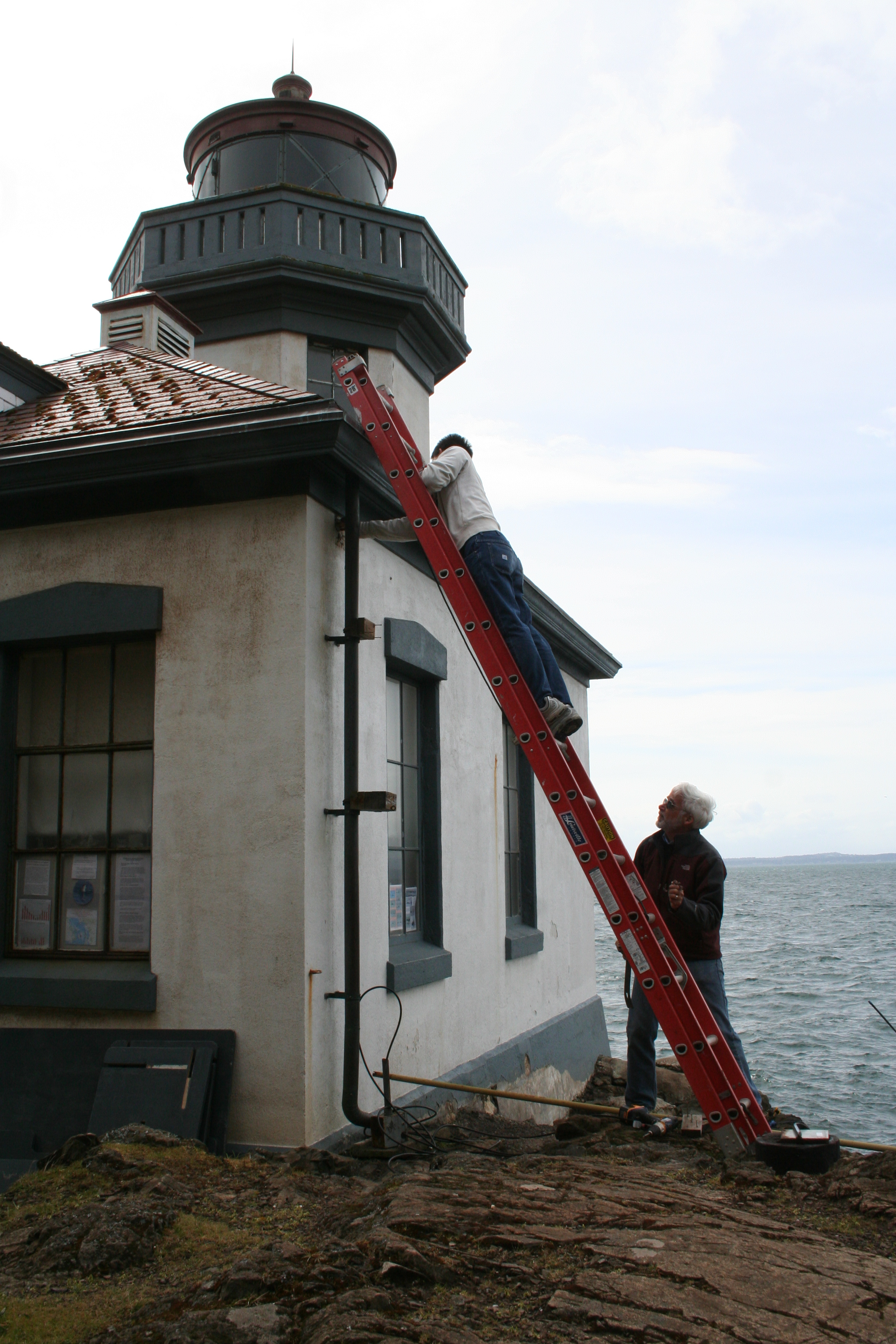
But the unexpected granted this week to be really adventurous indeed. Jason got a call to go pick up a Steller sea lion corpse off on one of the islands. And he called us to come along. So on Thursday, we needed out on the Buzzard, a small research vessel, to retrieve the corpse. It was a semi-windy afternoon when we left. We found it drifting alongside the shore of Lopez island. It was the first time I have ever seen such a humongous sea lion this close. It must have weighed over half a ton. After a tiresome couple of heaves, we got the humongous sea lion on board. However, the wind prevented us from going any further out in the open waters and thus, we had to leave it tied to the dock for the night. Even though we were not able to bring it back that exact moment, we began our trail back to the labs. The wind eventually grew much stronger, and water began to find its way into the boat. Because I sat on the front alongside Kathryn to balance the Buzzard, we ended up getting soaked from head to toe. But the whole journey was filled with nothing but jokes and laughter, even if we were getting pelted to the face by salt water. The next day, we set our course towards Lopez Island once more to retrieve that sea lion. This time, the sun was out with the least amount of wind that I have experienced here on the islands. Once we brought it back after an hour long boat ride, we contacted the people to perform a necropsy on the sea lion. I have never been so intrigued about anatomy in my life, after seeing a grown male Steller get dissected in front of my eyes. And to top the morning off, we were taught how to sail by Val in the afternoon! Nora and I made a couple of 360 degree turns out in the waters as Val and the others laughed. We figured how to get back to the dock eventually.
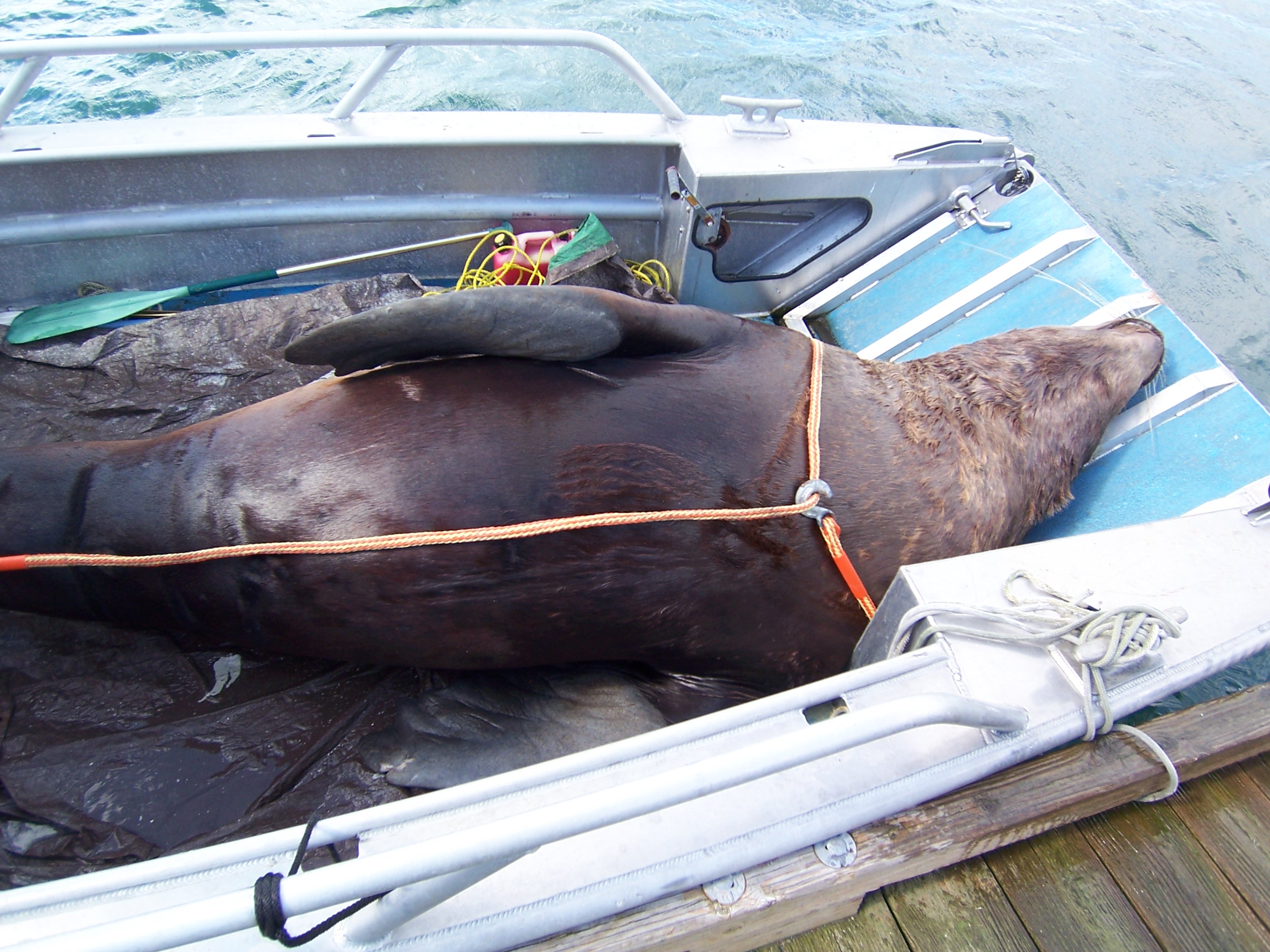
We finally finished our research proposals on Thursday and just got them returned an hour ago. It is soon getting closer and closer to the day when we actually can sail out and do our research!
Read More
Wow. Things have really picked up around here.
Each class portion builds on the material from the one before it, so I feel like I am becoming an expert in a variety of fields very quickly. This also means that the workload is starting to pull my brain in various directions as I try absorb each piece and appreciate the overall meaning of it.
We had a guest lecturer of particular interest to me named Anna Kagley visit our classroom yesterday to talk about the tracking of salmon populations throughout the shoreline. NOAA is expanding her study to the bays of San Juan Island, so there will soon be high frequency receivers strategically placed throughout the inner waters here. On a personal level, I was eager to distract her from this lecture (although that was also informative) to talk about a recent brain-trust type of seminar which labeled possible impacts of hydropower turbines around the world and at variable distribution levels. Oh how I would love to be even a fly on the wall at one of those meetings. Even if I were squished by the end, I think I would be satisfied to be a part of such meaningful and applied science. My imagination seems to thrive on the possibilities of what could happen, although my core also strives for practicality. This seems to be a perfect combination to draw me towards topics such as hydropower and establishing MPA’s on the west coast of San Juan Island. The scientist in me is slowly being satisfied and intensely awakened after being dormant in my realtor’s assistant body for so long. However, I must add that I am more technically savvy and better at solving problems than my college self. My heart is content to be on this current path. Anna said they are working with the County a lot, here is their website: http://www.snopud.com/PowerSupply/tidal.ashx?p=1155. Click on the “OpenHydro Technology†link to the right.
Typically, when there is a large piece of writing due (as was this morning), my body begins to yearn for the outdoors. Luckily, we are living in a biological preserve with great running trails. Just before dinner, I decided to take advantage of our surroundings and go for a jog. Once I realized that I forgot my camera, I knew it would be a memorable experience. First of all, the trail is sloped towards the middle and is therefore never really dry in this climate. A jog on this trail looks more like a dance with the Lost Boys (Peter Pan) than a form of exercise, which I must say, is where the 10 year old in me excels. I explored a little further than normal and discovered a cove along the beach that is quite protected from other visitors. There are huge mushrooms sprouting just inland of the coast, and even a bright purple seastar rigidly stuffed between rocks of the estuary-type environment. Clearly, if a girl from MN decided to take a nap on these rocks and forgot about the tides, you could be in for a rude awakening. Here is a typical outdoor photo from a different hike: 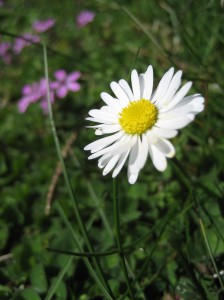
The jog was not complete without almost twisting an ankle, getting my foot completely sucked into a mud puddle, and scaring the snot out of an oblivious deer. Today, the sun is shining and it is bright enough to make cloud figures from the sky. Apparently it is supposed to snow for our sailing excursion tomorrow. Figures.
So, we were finishing lunch today (mac & cheese and tomato soup) when Jason found us with a gleam in his eye. He had just gotten a call about a floating (dead) stranded sea lion just off the coast of Lopez Island, and asked if we wanted to help retrieve it. Yea!! All four of us ran back to the house and threw on some warm clothes and rain gear, then headed out on “The Buzzard†across the Straight. Although they call it island hopping, we were not exactly hopping, or even skimming/fluttering – more like skuttering. Laughter filled the salty air as we set off on our adventure with the sun in the sky and the sea in our veins. The bumps and bruises didn’t matter because we were on the water again.
We arrived at the north end of Lopez Island and found a huge male Stellar sea lion with no indication of trauma, just death. It was quite a production for one instructor and four students to maneuver this guy against the will of gravity, the waves, and the wind but we were rewarded with eventual success. During the muscle-aching portion of our endeavor it began to snow/hail for about 8 minutes. My boots were already full of brisk salty sea so by that time I hardly noticed except to see the humor in it. The photo is of Jason and I trying to get the rope around the shoulders to haul it in the boat. 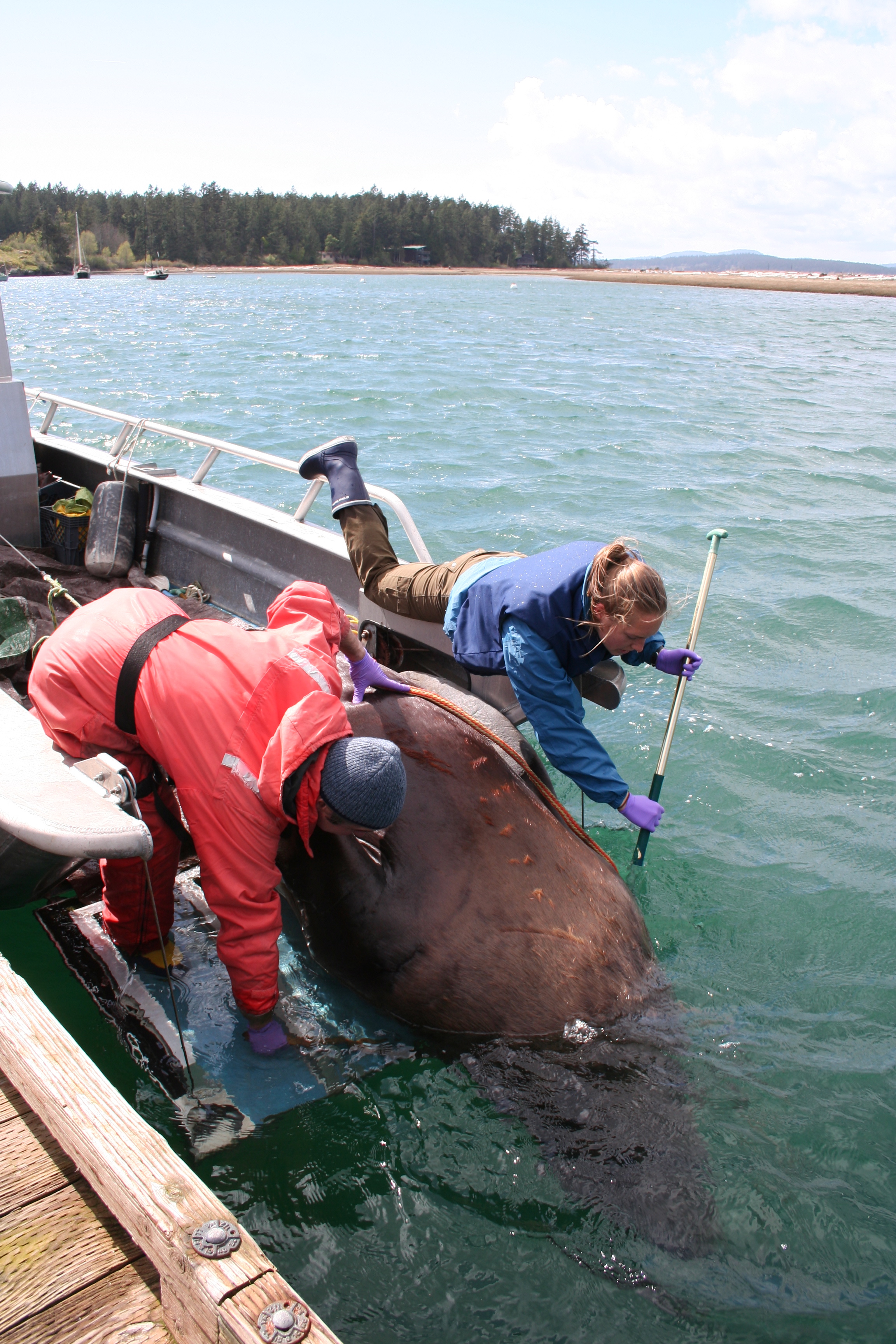 The sea lion filled the boat – making it look like merely a dingy with it’s massive flippers, torso, and head (length is 3.5 meters). I had never been so close to such a huge (and not moving) marine creature before and was able to let the scientist and the ten year old go free at the same time. The front four teeth are ground down to almost nothing, and the bottom ones that match them are about the same. They should really consider renaming the canine teeth, because the size on the ones in this guy’s mouth could out-bite pretty much any canine I know.
The sea lion filled the boat – making it look like merely a dingy with it’s massive flippers, torso, and head (length is 3.5 meters). I had never been so close to such a huge (and not moving) marine creature before and was able to let the scientist and the ten year old go free at the same time. The front four teeth are ground down to almost nothing, and the bottom ones that match them are about the same. They should really consider renaming the canine teeth, because the size on the ones in this guy’s mouth could out-bite pretty much any canine I know.
The ride home was cold, bumpy, and overall a drenching experience. The weather picked up and tried to mangle us to pieces, but the shower at our house has never been as appreciated as it was tonight.
The sea lion will be examined by real scientists tomorrow, and I am trying to finagle my way into the experience. Once again, I would love to be a fly on that wall.
Make the most of your day!
~libby
Read More
Hello
This whole week I’ve been having lots of fun looking up scientific papers in the library. I don’t think I fully realized that once you leave an institution, you also leave the privilege of having access to every journal article that they decide to subscribe to. It was like something lit inside me the other day when I started finding articles that are related to what I have been wondering about, then was able to click and save them on my desktop! I haven’t been this giddy about doing my own research maybe ever. Of course, compared to the research on earthworms (some of which had my best references in the early 1800’s) this is new, exciting, applicable stuff. I am right at the cusp of what is being done, and I can’t wait to get my hands dirty. I also think that I took too many to chew at once, but I will slowly make my way through the material.
I feel well-prepared for the tasks in front of me, and obviously, have taken to journaling quite well. There is something to be said about sitting on the back deck after dinner in your Chacos until you can’t see the keyboard or feel your toes. That being said, I am also having a hard time remembering how to sit down and come up with a specific topic, then write a scientific paper about it. I am devoting my Easter Sunday to figuring that out, reading a few applicable papers, and getting some words on a rough draft.
It is so dark and quiet at night that I find myself wishing that I knew the place well enough to be confident walk around without a flashlight. Don’t get me wrong, I keep neglecting to bring my headlamp for short trips to the library or computer lab because I have this innate need to prove that I can navigate without any aid, and then wishing that I had one. You see, campus is placed in the middle of a wildlife preserve which means that there is a high likelihood of an encounter with some woodsy creature. Most of the time, this would be a raccoon, but I have found that it is actually shadows that take away my comfortable confidence first. I have a vivid and ever-present imagination that sees skunks out of tree stumps and lagoon creatures out of rocks.
Sooner or later I will learn my lesson and bring a flashlight, but I also thoroughly enjoy the challenge in connecting to my surroundings with all of my natural senses. I enjoy the intense silence that the calm skies can bring, while I also am inspired by powerful winds on massive branches. There is nothing quite like a good storm in the middle of the woods. The other night I was grateful to be in my dry bed while listening to branches scratching the rooftops and rain pounding the gutters. The sound of the waves crashing on shore mixed with the cold chill of the breeze blowing up the bluff calms my senses until the wind finds the one spot where your skin is and it’s time to go in. I know that things are right with the world as long as the waves pound, the trees creak, and the wind chills my bones. Hopefully walking home without a flashlight will not turn into an unfortunate personality flaw that lands me in the hands of a rampant racoon looking for garbage. I must say that Beam Reach manages their trash well enough that I am not realistically concerned with this, but I have seen enough wild animals that my imagination is on full alert.
The night San Juan Island was struck, gail winds eventually blew the power out. It is harder to run classes, get research studies from the internet, cook/eat food, or even take showers with no power. These are things that are taken for granted until you live in a place where if the power is out, it might not come back on for days. Luckily, there is a backup generator on campus and the power was back on by the end of the day. We live in a world that is so driven by computers, internet and using energy that it is strange to go without it, even for a few hours.
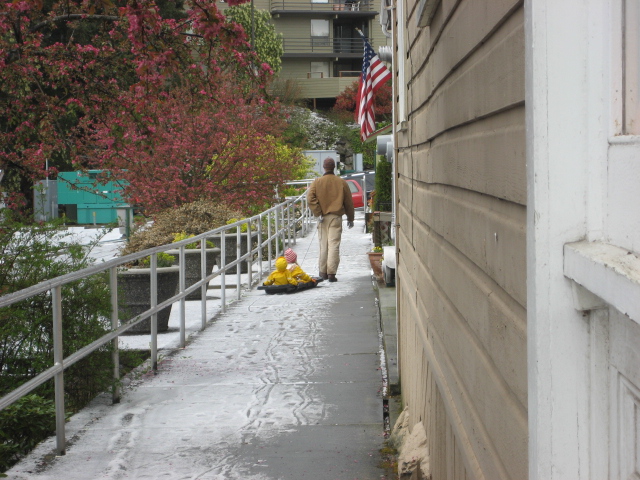
The wind was strong enough to disturb several wild animals out of their comfort zones. While sitting on the deck we watched a river otter run all around campus and even try to get into the basement of the house next door. For some reason, it decided to pose for long enough to grab some cameras and snap a few good shots. I am still trying to figure out why river otters would be here in the first place, but I am pretty sure sea otters never leave the water. This will probably remain a mystery to me.
Yesterday we walked to town to visit the Whale Museum. (http://www.whale-museum.org/)Â Â Being from Seattle, I knew enough to grab my raincoat and considered wearing rain-boots even though the morning was sunny and beautiful. The venture there was pretty uneventful, and the museum was about what I remembered from years ago. I have a better appreciation for the sound exhibit now though and was sure to spend some time gather details about J and K pod that I have never paid attention to before. While we were in the museum it rained like crazy, and then started to hail. There were large pellets of ice everywhere and streams of water with no where to go. I was grateful for my rain jacket and wished for my boots. A few scenes unfolded in the charming harbor town like an old shopkeeper shoveling the sidewalk and a young dad dragging two toddlers behind him in a sled. It was all melted in an hour, but for a moment it was like we were inside a precious snow globe with a major flurry before a calm.
Lastly, I also just found out that there is a close knit network of people that follow the whales pretty extensively and of course, they are up to date with the latest technologies. By this I mean that if anyone that lives near the ocean or is paying attention to where any whales are moving, they “tweet†about it. My instructors get text messages of “tweets†that inform them about the latest information of where the whales are, which pod it might be, and any other interesting information they can come up with. I understand the useful nature of all of this information and thoroughly enjoy the efficient ways to communicate with everyone about it. However, every time my instructor gets a text tweet in my presence, I have contained every joke that pops into my head and limit myself to a smile. Seriously, I know that whales communicate through clicks, pulsed calls, and whistles, but tweets? You’ve got to be kidding me.
These things just get better everyday.
Happy Easter!
~Libby
Read More
A week has gone by since I first set foot on the San Juan Islands. Coming from San Francisco, my body has not fully assimilated to the colder temperatures here up in the northwest. Arriving via the ferry from Anacortes, this is my first time on the San Juan Islands. My very first impression of the Friday Harbor Labs was a good one. There was this sense of a small family community here, much like my old high school back two years ago.  It is very different from being in a large lecture hall filled with nothing but hundreds of students. This year in Beam Reach’s spring 2010 program, including myself, there are only four students. I feel this is a great opportunity for us to get to know all the instructors one-on-one, enabling a much more in depth relationship towards each other. Personally, I think a small teaching environment is very rigorous and demanding, but yet again, the experience grants one more friends, support, and encouragement to do better.
On the first week, we were able to learn a lot of the basics of acoustics and how sound works. I learned a lot of new things that I have never been taught before, and things were revisited that I should have remembered back long ago. Being the youngest one of the Beam Reach group and a second year undergraduate at UC Davis, I have never had much experience in dealing with loads of reading on a “close to graduate level†expectation level. The first week dealt with plenty of article reading that we discussed later on during the days in class. The discussions went well, delving into topics about the southern resident killer whales’ endangerment status, to the influences of boat noises underwater. Our instructors, Dr. Jason Wood, Dr. Val Veirs, and Dr. Scott Veirs, provided us with a general background to the southern resident killer whales’ world in the northwest. Acoustics, involving graphs, physics, and noise, really blew my mind. Even though it might take a while for me to personally adjust to this hard-working environment, I will try my best to keep up with the pace. Moreover, I would love to take the lead sometimes in the group and help others out as I anticipate the amount of help I shall receive.
We visited the Lime Kiln Lighthouse on the second day of the week, where we formulated our five initial questions to help narrow our thoughts to a potential research question that we will be answering over the course of these ten weeks.  From the photo, the lighthouse can be seen with my two fellow classmates in the background, Kathryn and Nora. When the weather permitted, we strolled by the docks.
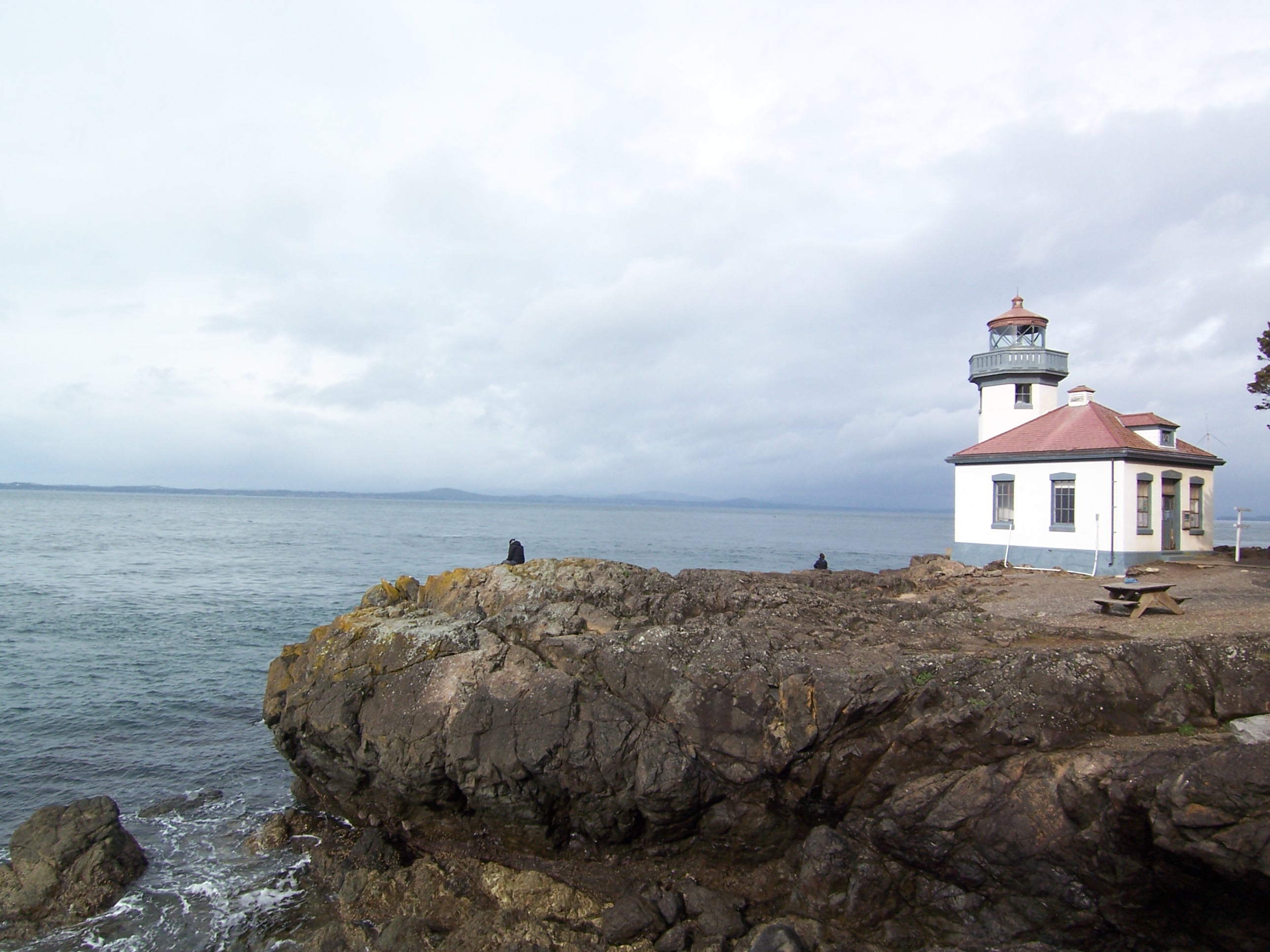
But the most interesting place that we went to was indeed the Whale Museum in town. Walking there took about half an hour, but that time was worth it. Although small, I felt that this museum really emphasized that sense of specification with the southern killer whales and other marine species in this particular northwest area. The exhibits really portrayed what are affecting the species and how we can protect them. One exhibit that really stuck out to me though, was the acoustic exhibit, created by Dr. Val Veirs himself. I thought that this exhibit can give the public a general idea of the effects of fluctuating noise levels in the ocean that can cause an irritation to the killer whales. I had so much fun twiddling around with the different sounds and buttons on the dashboard, quizzing myself to the various calls of the southern resident killer whales out there.
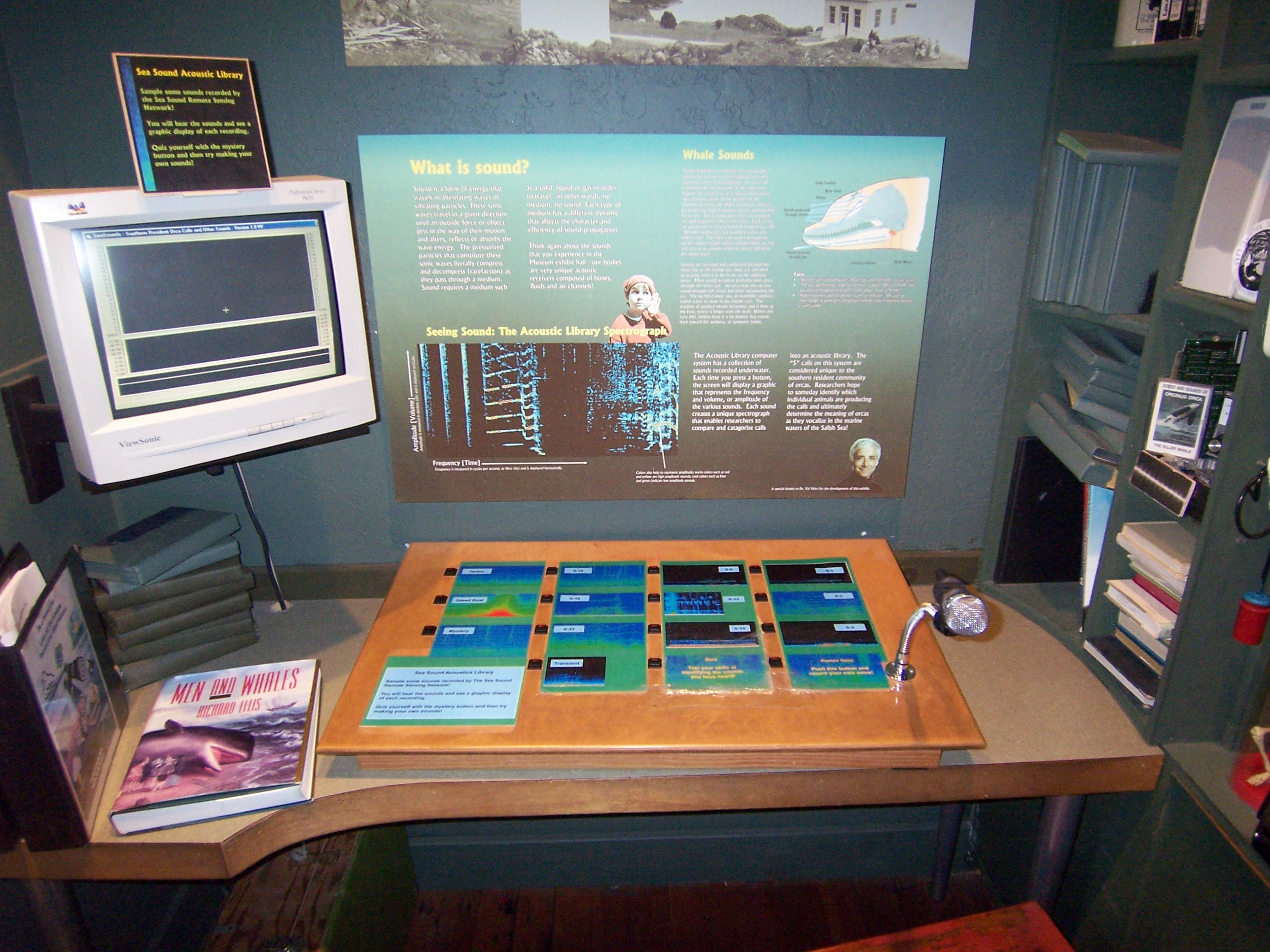
Weather was decent the first week, with much sun, with a gale on Friday and Saturday. :]
Read More
Greetings,
Today we walked through names of machines that look fragile and are minimally $1,000 a piece. Apparently if the word “acoustic†is used in the device name, you can assume at least a grand was put into it. Needless to say, I was not sticking my fingers on each button or playing around like I usually would, but I feel like my time will come. Cross your fingers for me that I don’t accidentally knock a particular orange or blue box into the Salish sea somewhere along our journey. I think one of the forms that we signed said that they replace those boxes with our first born child. So….none of that.
I am starting to wish that I still had my notes (or that fancy Iphone application) to help identify the birds in the area. I am familiar with Midwest ornithology, but have to admit that I would love to know the names of the annoying screeching birds in the tree just above the back deck. I also should know the names of several beautiful singers outside my window in the morning. It is now that I wish I could pull my ornithology professor out of my pocket and have an opportunity to expand on what I know. Luckily, the professors keep bringing books for our own personal Beam Reach library to the duplex and I think there is a bird identification guide there. We did discover that the loud ringing noise every early morning is a Northern Red Shafted Flicker marking it’s territory. Here’s all about it: http://www.allaboutbirds.org/guide/Northern_Flicker/sounds
One of the coolest things I was able to see today was not an ocean organism at all, but a charming red fox crossing my path on the way to the dining hall. I was able to snap a few pictures, and although it looks like the animal was far away, I assure you that it was a close and personal encounter. I wonder if this is the only one in the area? What does it feed on? Has anyone done a population survey of the red foxes on the island? I also will expand my wondering to how they got here in the first place? I don’t seem to know enough about the natural history of San Juan Island to know when the last glacial period has been. However, I can easily inform you that the worm population in Northern Wisconsin is mostly invasive and were brought to the land from England accidentally as soil supplements in plants or have been released by recreational fishers.
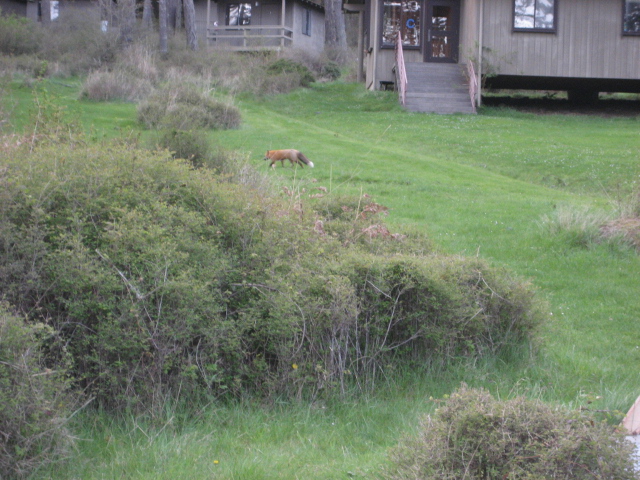
Anyways, my class spent another portion of the day exploring research topics from past Beam Reach students. When I was first thinking about joining the program I read through the titles and abstracts of most of past student papers, but it was refreshing to start thinking about how to connect those projects to my peak interests. As a biologist, it is clear that regardless of the sweat and tears put into the research topic, there will be a statistical challenge at the end of the program when you find the challenges of making anything statistically significant given the sample size. Anyone the publishes findings and are respected for their research have done experiments over and over again to find true conclusions. With this in mind, I will attempt to connect my research to a dataset from one of a past student. I am interested in the human impacts (aka boat noise) on the behavior of the Southern Residents. There has been increased attention on regulation in the area since NOAA is debating making a significant portion of the West side of the island a Marine Protected Area. Basically, this would mean that any vessel (including canoes and kayaks) cannot enter the water in the MPA. I am not sure if this is according to a particular season, but I believe that it would be in effect year round. I am excited to take part in the process from this point forward. I have been in tune with the changes in regulation and will work on gaining experience on how an MPA is created and what that means for all parties involved. I think that this is the right time to ask around and make observations of various opinions on the proposed changes. This is where the Anthropologist in my wants to run free.
The other thing that peaked my interest today was expanding my ideas about hydropower. I am usually in full support of alternative energy technology and was a bit surprised that I hadn’t thought about the details of how the ecosystem might be impacted. It seems like no one really has an answer to this question, even though there is a tidal generator newly installed in Puget Sound. I can only imagine the impacts that filtering water into a spinning system would have on all of the micro-organisms floating in that same water. Maybe it won’t impact the quality of life at all…..I just wonder what is being done to verify that. Jason also said that in Britain they have developed technology that slows the propulsion blades when whales are present, but that the technology hosted a frequency that caused hemorrhaging in sea lion brains to do so. I think that it might be important to realize that while implementing alternative energy technology is very important, we also need to learn from historical environmental errors and observe all potential impacts before declaring that something is safe and installing technologies around the world. Let’s take our time on this one and make sure that it’s done right. Scientists may not have all the answers now, but we will have them once things start happening. It’s best if those things happen in a controlled, single environment instead of around the whole world. Slow and steady may win the race here.
We keep getting to hear recordings of the orcas. Some transients were even recorded off of Lime Kiln State Park last night. Hopefully we will catch a live feed from a hydrophone soon. I am starting to catch whale fever so it would really be nice to at least hear proof that they exist.
Attached is the campus red fox. I haven’t lost my camera yet… see?
Have a wonderful day : )
Read More
Hello!
I am alive and settled;
My first two days at Friday Harbor have been very exciting and I will share as much with you as you are willing to read. It is beautiful, green , spacious, laid back, quiet (except for the bobcat in front of our cabin at the moment), and basically unreal on all levels.
I met the other members of Beam Reach at the Seattle Aquarium on Saturday morning, for an eye-opening experience. The aquarium is much bigger than I had first anticipated and includes a neat exhibit that was designed to educate the general public about comparing whales to humans both anatomically and socially. There is also a sonar display where you can compare the different sounds of several animals, boats, harbors, and even create your own sonogram. We went to the back where a hydrophone picks up and records sounds of downtown Seattle. The port is notoriously noisy and (not surprisingly) the orca resident pod has not really been seen in the port for a long time. You can listen live here:Â orcasound.net
The sun and rain have been taking turns on and off as seemingly regular as the ferry schedule since I’ve been here. I packed my bag in preparation as we ventured to Lime Kiln State Park, also known as Whale Watch State Park. One of the signs says that on any given day in the summer, there is a 30% chance of seeing a whale during that day. We were able to spot a few Stellar sea lions bobbing around and quite a number of sailboats, but no orcas. We were briefed by Scott Veirs and Jason Wood (who are two of the mentors for the program) on various types of sound data analysis programs and listened to recorded orca calls. We were sent out to the rocks during one of the sunny periods to think of questions about the whales and ecosystem in general. Of course, my questions spun in circles towards hydropower impacts, the logistics of developing marine protected areas, and wondering where the San Francisco sea lions are now….

The dining hall staff seems wonderful and very organized. I am impressed by the accommodations (and patience) that they seem to have for strange allergies and food preferences. Although I was concerned about my preference to not eat or smell seafood, they don’t give it a second thought.
It seems that most of the homework is going to be reading scholar papers about various marine/ecosystem topics, which should be really good for me. As the days get longer I have a feeling that the time I start reading will get later and later, at least until we get on the boat. I will be venturing out on a bike and taking hikes as frequently as possible. These things tend to turn into epic tales, so be sure to stay tuned.
Take care! Enjoy the day!!
Read More
 On my first jump, after getting over the sudden “oh my god so cold!!†feeling, I swam over and climbed up the ladder that leads up to the tall dock. On my second jump Horace and I, with a 3..2..1.. countdown/encouragement from Val, jumped from the tall dock. I have to say, the stomach dropping feeling of jumping from high places does nothing to distract from the cold shock. On his first dive off of the tall dock, Val did an amazing swan dive. It turns out he used to dive competitively. Cool hunh!
On my first jump, after getting over the sudden “oh my god so cold!!†feeling, I swam over and climbed up the ladder that leads up to the tall dock. On my second jump Horace and I, with a 3..2..1.. countdown/encouragement from Val, jumped from the tall dock. I have to say, the stomach dropping feeling of jumping from high places does nothing to distract from the cold shock. On his first dive off of the tall dock, Val did an amazing swan dive. It turns out he used to dive competitively. Cool hunh!























 The sea lion filled the boat – making it look like merely a dingy with it’s massive flippers, torso, and head (length is 3.5 meters). I had never been so close to such a huge (and not moving) marine creature before and was able to let the scientist and the ten year old go free at the same time. The front four teeth are ground down to almost nothing, and the bottom ones that match them are about the same. They should really consider renaming the canine teeth, because the size on the ones in this guy’s mouth could out-bite pretty much any canine I know.
The sea lion filled the boat – making it look like merely a dingy with it’s massive flippers, torso, and head (length is 3.5 meters). I had never been so close to such a huge (and not moving) marine creature before and was able to let the scientist and the ten year old go free at the same time. The front four teeth are ground down to almost nothing, and the bottom ones that match them are about the same. They should really consider renaming the canine teeth, because the size on the ones in this guy’s mouth could out-bite pretty much any canine I know.






 Twitter
Twitter LinkedIn
LinkedIn Facebook
Facebook